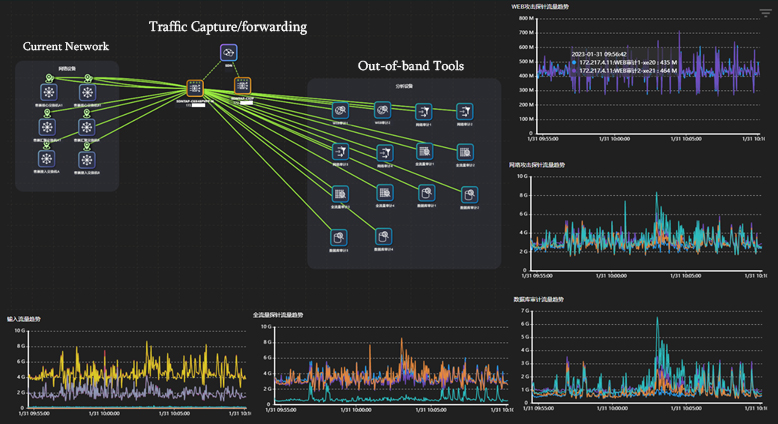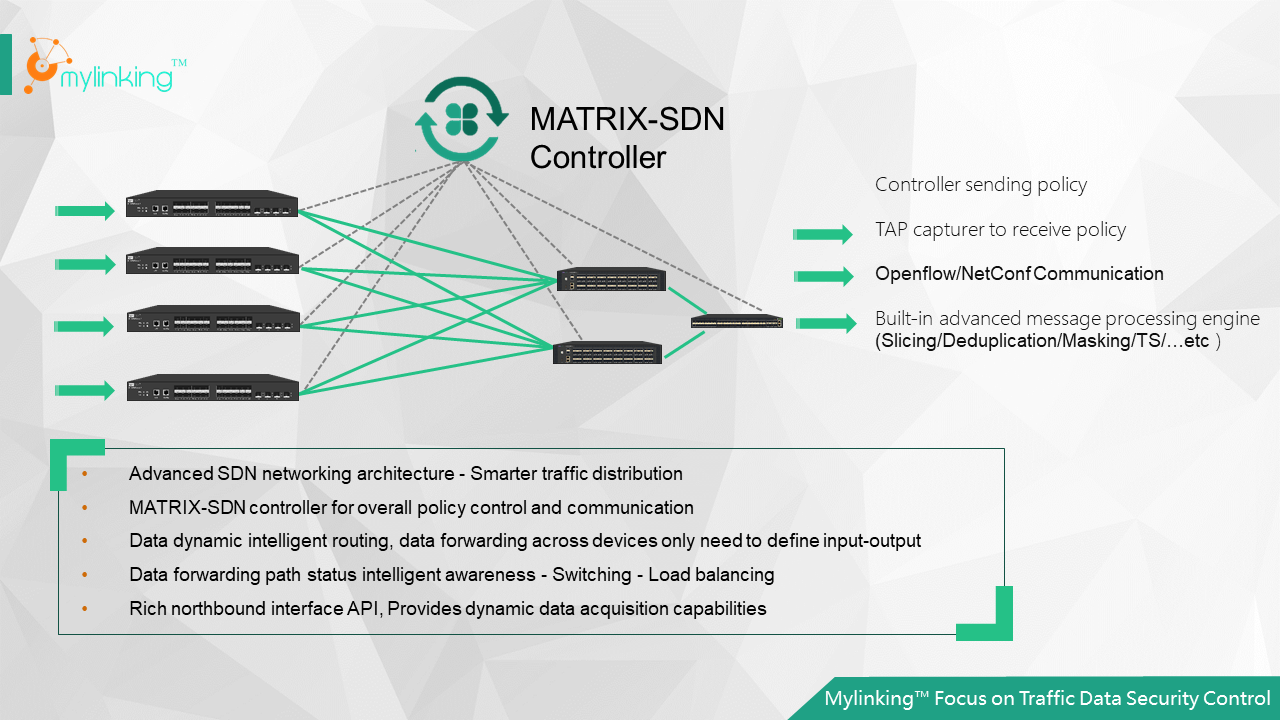In today's rapidly evolving networking landscape, efficient traffic data control is essential for ensuring optimal network performance and security. Mylinking Matrix-SDN Traffic Data Control Solution offers an advanced technology architecture based on Software-Defined Networking (SDN) principles. Leveraging the power of SDN, this solution provides smarter traffic distribution, comprehensive policy control, dynamic intelligent routing, and rich API interfaces for dynamic data capture. In this blog post, we will delve into the features and benefits of Mylinking Matrix-SDN Traffic Data Control Solution, focusing on its capabilities as a Network Packet Broker and Network Tap.
Mylinking Matrix-SDN Traffic Data Control Solution of Network Packet Broker and Network Tap offers a powerful and flexible approach to traffic data control in modern networks. By leveraging SDN principles, it enables smarter traffic distribution, comprehensive policy control, dynamic intelligent routing, and rich API interfaces. With these capabilities, network administrators can optimize network performance, enhance security, and gain deeper insights into their network traffic. Embracing this advanced SDN architecture can significantly transform the way organizations manage and control their network traffic data.
1. Advanced SDN Networking Architecture - Smarter Traffic Distribution:
Mylinking Matrix-SDN Traffic Data Control Solution is built on an advanced SDN networking architecture. By decoupling the network's control plane from the data plane, it enables centralized control and management of traffic flows. This architecture allows for smarter traffic distribution, ensuring that network resources are utilized efficiently and traffic is directed to the appropriate destinations. As a Network Packet Broker and Network Tap solution, Mylinking Matrix-SDN Traffic Data Control Solution allows administrators to apply traffic filtering and inspection mechanisms to monitor and analyze network traffic. This includes deep packet inspection, protocol analysis, and content filtering. By analyzing the contents of network packets, the solution can identify malicious activities, detect intrusion attempts, and enforce security policies at the network level.
2. MATRIX-SDN Controller for Overall Policy Control and Communication:
At the heart of the Mylinking Matrix-SDN Traffic Data Control Solution lies the MATRIX-SDN controller. This controller serves as the centralized management platform, offering overall policy control and communication capabilities. It allows network administrators to define and enforce traffic policies, ensuring that data flows adhere to specific rules and requirements. The MATRIX-SDN controller acts as a decision-making entity, orchestrating the traffic control actions across the network. The MATRIX-SDN controller in Mylinking Matrix-SDN Traffic Data Control Solution serves as the centralized management platform for defining and enforcing traffic policies. This allows network administrators to establish granular security policies, such as access control rules, traffic filtering, and threat detection mechanisms. By centrally managing and implementing these policies, the solution ensures consistent and uniform security enforcement across the network.
3. Data Dynamic Intelligent Routing, Data Forwarding Across Devices Only Need to Define Input-Output:
One of the key features of Mylinking Matrix-SDN Traffic Data Control Solution is its data dynamic intelligent routing mechanism. With this capability, the solution enables efficient and flexible data forwarding across devices. By defining the input-output paths, network administrators can easily specify how data should flow through the network. This eliminates the need for complex device-specific configurations, simplifying the management of traffic data and reducing operational overhead. The solution's dynamic intelligent routing capability plays a crucial role in enhancing network security. It enables administrators to define specific data forwarding paths based on security requirements. This allows them to segment sensitive traffic flows, isolate critical network segments, and create security zones. By enforcing strict routing policies, the solution helps prevent unauthorized access to sensitive data and minimizes the impact of security breaches.
4. Data Forwarding Path Status Intelligent Awareness - Switching - Load Balancing:
The Mylinking Matrix-SDN Traffic Data Control Solution incorporates intelligent awareness of data forwarding path status. This means that the solution constantly monitors the network's conditions, such as link utilization, congestion, and device availability. Based on this information, it dynamically adapts the data forwarding paths, ensuring optimal switching and load balancing. This capability leads to improved network performance, reduced latency, and enhanced fault tolerance. The data forwarding path status intelligent awareness feature of the solution contributes to network security by ensuring load balancing and redundancy. By dynamically adapting data forwarding paths based on network conditions, it helps distribute traffic evenly across the network, preventing bottlenecks and reducing the risk of targeted attacks. Additionally, in the event of a network failure or security incident, the solution can automatically reroute traffic to redundant paths, ensuring continuity of operations and mitigating potential vulnerabilities.
5. Rich Northbound Interface API, Provides Dynamic Data Capture Capabilities:
To empower network administrators with comprehensive control and visibility, Mylinking Matrix-SDN Traffic Data Control Solution offers a rich northbound interface API. This API provides a set of programmable interfaces that allow seamless integration with external applications and tools. With these interfaces, administrators can dynamically capture data from the network, perform real-time analysis, and extract valuable insights. The rich API ecosystem enables the solution to be customized and extended according to specific requirements. Mylinking Matrix-SDN Traffic Data Control Solution provides rich northbound interface APIs that enable real-time monitoring and analysis of network traffic. Administrators can leverage these interfaces to capture and analyze traffic data, detect anomalies, and identify potential security threats. By promptly detecting and responding to security incidents, network administrators can effectively mitigate risks and minimize the impact of security breaches.
While centralized policy control in Mylinking Matrix-SDN Traffic Data Control Solution offers numerous benefits, there are also certain limitations and challenges that organizations may encounter during implementation. Here are some factors to consider:
1. Complexity of Policy Definition: Defining and managing policies in a centralized manner can be complex, especially in large-scale networks. Organizations need to carefully plan and document their policy requirements, considering factors such as access control rules, traffic filtering criteria, and QoS priorities. Ensuring the accuracy and consistency of policies across the network requires a thorough understanding of the network topology and the specific security and operational requirements of the organization.
2. Scalability and Performance: As the network grows in size and complexity, the scalability and performance of the centralized policy control mechanism become crucial. The MATRIX-SDN controller must have the capacity to handle a large number of policy rules and effectively process and enforce them in real-time. Inadequate scalability or performance can lead to delays in policy enforcement, affecting network responsiveness and potentially introducing security vulnerabilities.
3. Integration and Interoperability: Integrating Mylinking Matrix-SDN Traffic Data Control Solution into an existing network infrastructure may require compatibility with various networking devices, protocols, and management systems. Ensuring seamless integration and interoperability can be a challenge, particularly if the network consists of diverse hardware and software components. Careful planning, testing, and coordination with vendors may be necessary to overcome these integration challenges.
4. Policy Consistency and Enforcement: Centralized policy control relies on consistent enforcement of policies across the network. However, inconsistencies can arise due to factors such as misconfigurations, software bugs, or device failures. It is important to have mechanisms in place to monitor and validate policy enforcement to ensure that policies are consistently applied and violations are promptly detected and addressed.
5. Organizational Change and Skill Requirements: Implementing centralized policy control may require organizations to adapt their operational processes and procedures. It may involve changes in network management workflows, security practices, and skill requirements for network administrators. Organizations should plan for training and knowledge transfer to ensure that the personnel responsible for policy management and enforcement have the necessary expertise.
6. Security and Resilience of the Controller: The security and resilience of the MATRIX-SDN controller itself are critical considerations. The controller should be protected against unauthorized access, vulnerabilities, and attacks. Robust security measures, such as strong authentication mechanisms, encryption, and regular updates, should be implemented to safeguard the controller and prevent potential security breaches.
7. Vendor Support and Ecosystem Maturity: The availability of vendor support and the maturity of the SDN ecosystem can impact the successful implementation of centralized policy control. Organizations should evaluate the track record and reputation of the solution provider, assess the availability of technical support, and consider the ecosystem of compatible products and tools that can enhance the functionality of the solution.
It is important for organizations to thoroughly assess these limitations and challenges and develop a well-defined implementation plan to address them effectively. Engaging with experienced professionals, conducting pilot deployments, and closely monitoring the performance and security of the centralized policy control mechanism can help mitigate these challenges and ensure a successful
Post time: May-14-2024







